| Strain Name |
C57BL/6-Pvrigtm1(PVRIG)Bcgen/Bcgen
|
Common Name | B-hPVRIG mice |
| Background | C57BL/6 | Catalog number | 110091 |
|
Related Genes |
CD112R; C7orf15 | ||
|
NCBI Gene ID |
102640920 | ||
mRNA expression analysis
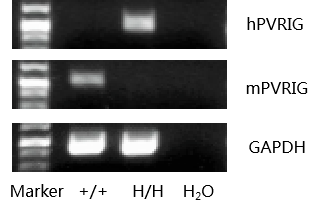
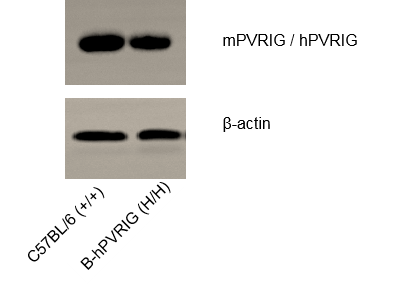
PVRIG expression analysis in homozygous B-hPVRIG mice by western blot. Heart collected from wild type and homozygous B-hPVRIG mice (H/H) and analyzed by western blot with anti-PVRIG antibody. Mouse PVRIG was detectable in wild-type mice. Human PVRIG was detectable in homozygous B-hPVRIG mice. Anti-PVRIG antibody is crossly reactive with PVRIG in human and mice.
Analysis of spleen leukocytes cell subpopulations in B-hPVRIG mice

Analysis of spleen leukocyte subpopulations by FACS. Splenocytes were isolated from female C57BL/6 and B-hPVRIG mice (n=3, 8-week-old). Flow cytometry analysis of the splenocytes was performed to assess leukocyte subpopulations. A. Representative FACS plots. Single live cells were gated for the CD45+ population and used for further analysis as indicated here. B. Results of FACS analysis. Percent of T cells, B cells, NK cells, dendritic cells, granulocytes, monocytes and macrophages in homozygous B-hPVRIG mice were similar to those in the C57BL/6 mice, demonstrating that introduction of hPVRIG in place of its mouse counterpart dose not change the overall development, differentiation or distribution of these cell types in spleen. Values are expressed as mean ± SEM.
Analysis of spleen T cell subpopulations in B-hPVRIG mice
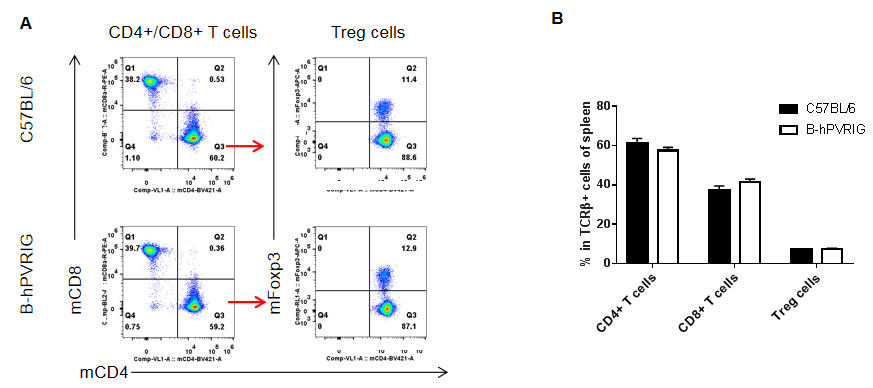
Analysis of spleen T cell subpopulations by FACS. Splenocytes were isolated from female C57BL/6 and B-hPVRIG mice (n=3, 8-week-old). Flow cytometry analysis of the splenocytes was performed to assess leukocyte subpopulations. A. Representative FACS plots. Single live CD45+ cells were gated for CD3+ T cell population and used for further analysis as indicated here. B. Results of FACS analysis. The percent of CD4+ T cells, CD8+ T cells and Treg cells in homozygous B-hPVRIG mice were similar to those in the C57BL/6 mice, demonstrating that introduction of hPVRIG in place of its mouse counterpart does not change the overall development, differentiation or distribution of these T cell subtypes in spleen. Values are expressed as mean ± SEM.
Analysis of blood leukocytes cell subpopulations in B-hPVRIG mice

Analysis of blood leukocyte subpopulations by FACS. Blood cells were isolated from female C57BL/6 and B-hPVRIG mice (n=3, 8-week-old). Flow cytometry analysis of the splenocytes was performed to assess leukocyte subpopulations. A. Representative FACS plots. Single live cells were gated for the CD45+ population and used for further analysis as indicated here. B. Results of FACS analysis. Percent of T cells, B cells, NK cells, dendritic cells, granulocytes, monocytes and macrophages in homozygous B-hPVRIG mice were similar to those in the C57BL/6 mice, demonstrating that introduction of hPVRIG in place of its mouse counterpart does not change the overall development, differentiation or distribution of these cell types in spleen. Values are expressed as mean ± SEM.
Analysis of blood T cell subpopulations in B-hPVRIG mice
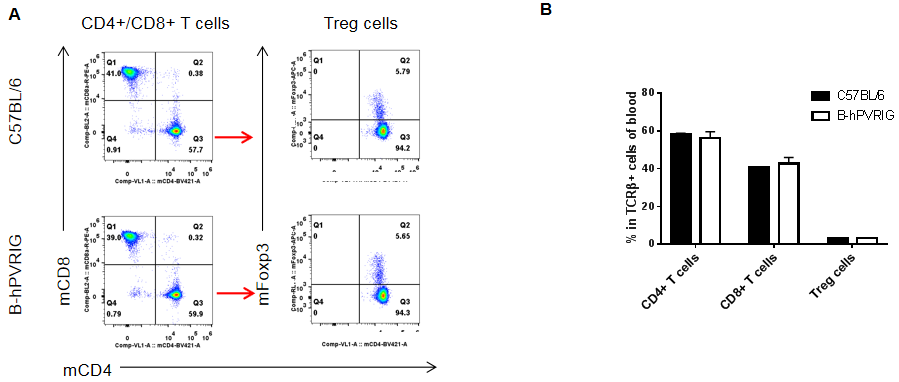
Analysis of blood T cell subpopulations by FACS. Blood cells were isolated from female C57BL/6 and B-hPVRIG mice (n=3, 8-week-old). Flow cytometry analysis of the splenocytes was performed to assess leukocyte subpopulations. A. Representative FACS plots. Single live CD45+ cells were gated for CD3+ T cell population and used for further analysis as indicated here. B. Results of FACS analysis. The percent of CD4+ T cells, CD8+ T cells and Treg cells in homozygous B-hPVRIG mice were similar to those in the C57BL/6 mice, demonstrating that introduction of hPVRIG in place of its mouse counterpart does not change the overall development, differentiation or distribution of these T cell subtypes in spleen. Values are expressed as mean ± SEM.
Analysis of Lymph node leukocytes cell subpopulations in B-hPVRIG mice
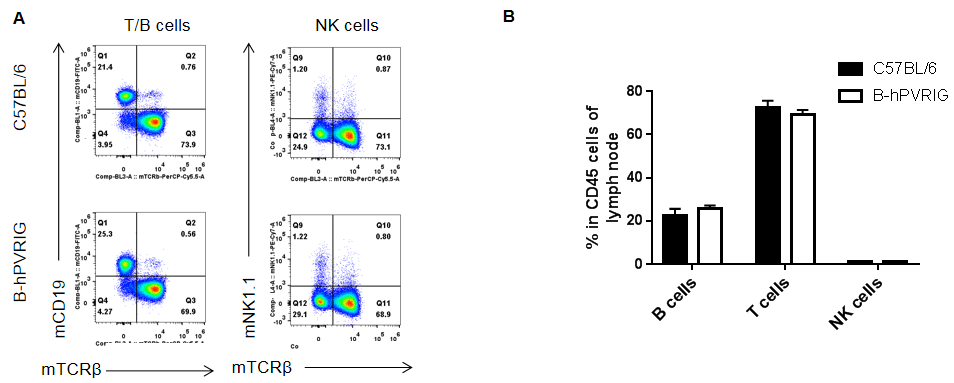
Analysis of lymph node leukocyte subpopulations by FACS. lymph node were isolated from female C57BL/6 and B-hPVRIG mice (n=3, 8- week-old) Flow cytometry analysis of the leukocytes was performed to assess leukocyte subpopulations. A. Representative FACS plots. Single live cells were gated for CD45+ population and used for further analysis as indicated here. B. Results of FACS analysis. The percent of T cells, B cells and NK cells in homozygous B-hPVRIG mice were similar to those in the C57BL/6 mice, demonstrating that introduction of hPVRIG in place of its mouse counterpart does not change the overall development, differentiation or distribution of these cell types in lymph node. Values are expressed as mean ± SEM.
Analysis of Lymph node T cell subpopulations in B-hPVRIG mice
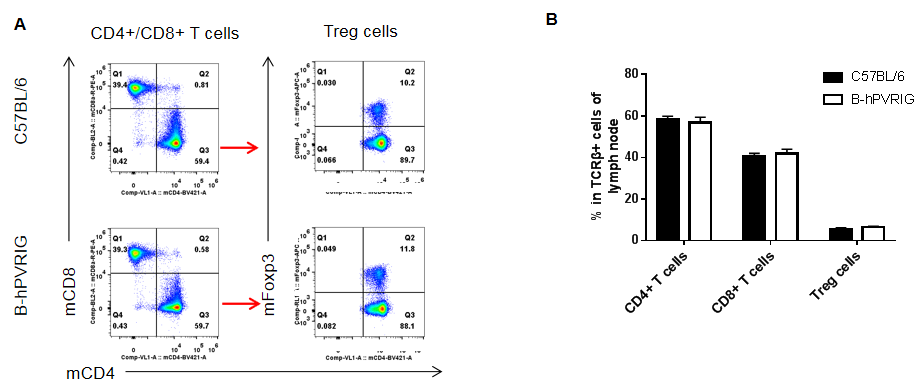
Analysis of lymph node T cell subpopulations by FACS. lymph node were isolated from female C57BL/6 and B-hPVRIG mice (n=3, 8-week-old). Flow cytometry analysis of the lymph node was performed to assess leukocyte subpopulations. A. Representative FACS plots. Single live CD45+ cells were gated for CD3+ T cell population and used for further analysis as indicated here. B. Results of FACS analysis. The percent of CD4+ T cells, CD8+ T cells and Treg cells in homozygous B-hPVRIG mice were similar to those in the C57BL/6 mice, demonstrating that introduction of hPVRIG in place of its mouse counterpart does not change the overall development, differentiation or distribution of these T cell subtypes in spleen. Values are expressed as mean ± SEM.
In vivo efficacy of anti-human PVRIG antibodies
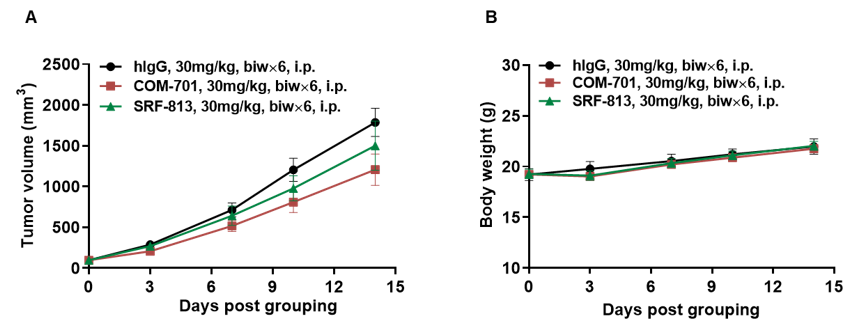
In vivo efficacy of anti-human PVRIG antibodies










